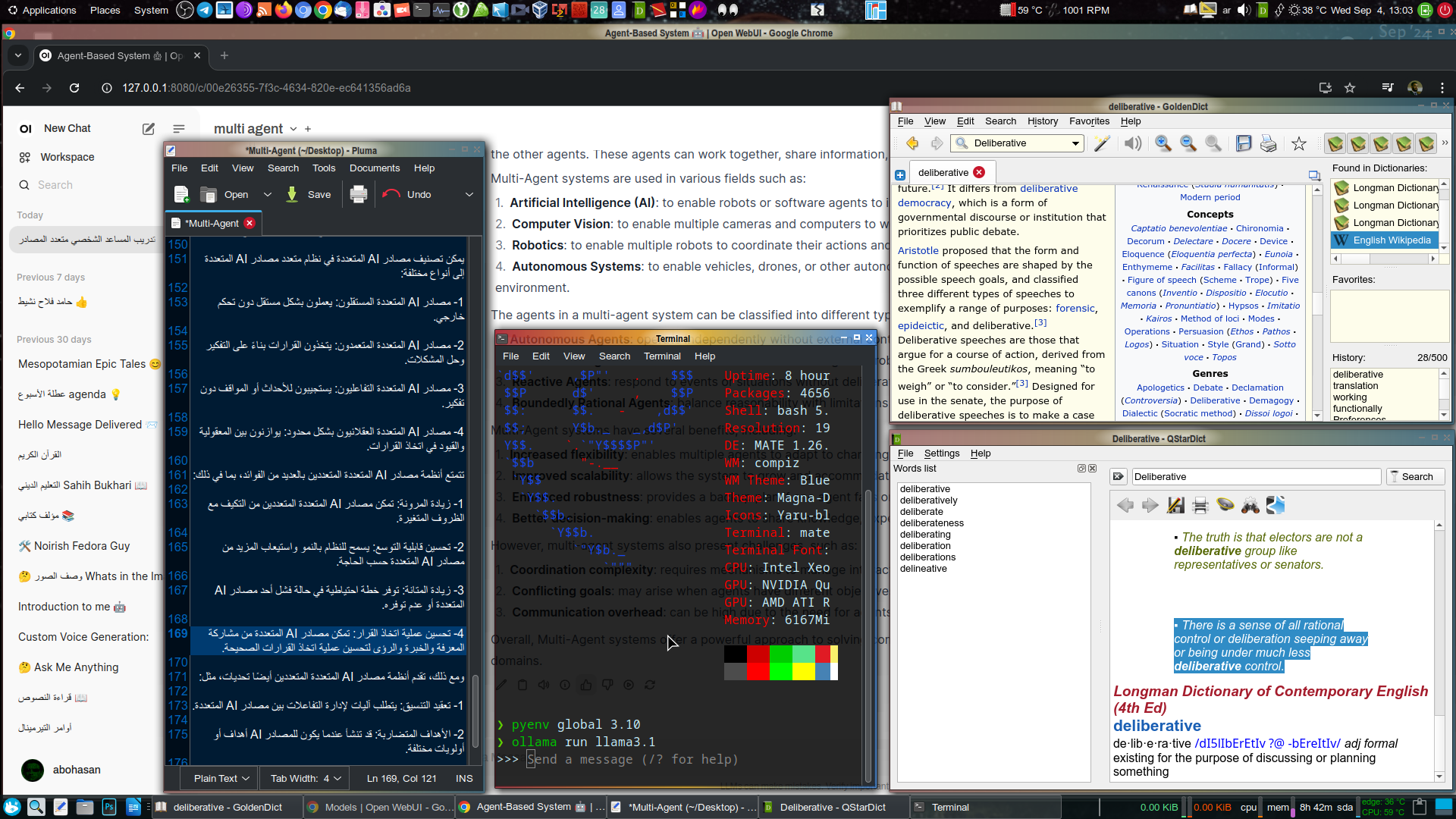
يشير مصطلح تعدد مصادر AI المتعددة إلى نظام يتكون من مصادر AI أذكياء متعددين (برامج أو كيانات) يتفاعلون مع بعضهم البعض ومع بيئتهم لتحقيق هدف مشترك أو حل مشكلة معقدة.
في نظام متعدد مصادر AI المتعددة، يتمتع كل وكيل بقدراته ومعارفه وأهدافه الخاصة، والتي قد تختلف عن تلك الخاصة بمصادر AI المتعددة الآخرين. يمكن لهؤلاء مصادر AI المتعددة العمل معًا ومشاركة المعلومات والتعاون لتحقيق هدف مشترك.
تُستخدم أنظمة تعدد مصادر AI المتعددة في مجالات مختلفة مثل:
1- الذكاء الاصطناعي (AI): لتمكين الروبوتات أو مصادر AI البرامجية من التفاعل مع بعضهم البعض ومع بيئتهم.
2- الرؤية الحاسوبية: لتمكين كاميرات وأجهزة كمبيوتر متعددة من العمل معًا لتحليل الصور أو مقاطع الفيديو.
3- الروبوتات: لتمكين روبوتات متعددة من تنسيق أفعالها وتحقيق هدف مشترك.
4- الأنظمة المستقلة: لتمكين المركبات أو الطائرات بدون طيار أو الأنظمة المستقلة الأخرى من التفاعل مع بعضها البعض ومع بيئتها.
يمكن تصنيف مصادر AI المتعددة في نظام متعدد مصادر AI المتعددة إلى أنواع مختلفة:
1- مصادر AI المتعددة المستقلون: يعملون بشكل مستقل دون تحكم خارجي.
2- مصادر AI المتعددة المتعمدون: يتخذون القرارات بناءً على التفكير وحل المشكلات.
3- مصادر AI المتعددة التفاعليون: يستجيبون للأحداث أو المواقف دون تفكير.
4- مصادر AI المتعددة العقلانيون بشكل محدود: يوازنون بين المعقولية والقيود في اتخاذ القرارات.
تتمتع أنظمة مصادر AI المتعددة بالعديد من الفوائد، بما في ذلك:
1- زيادة المرونة: تمكن مصادر AI المتعددة المتعددين من التكيف مع الظروف المتغيرة.
2- تحسين قابلية التوسع: يسمح للنظام بالنمو واستيعاب المزيد من مصادر AI المتعددة حسب الحاجة.
3- زيادة المتانة: توفر خطة احتياطية في حالة فشل أحد مصادر AI المتعددة أو عدم توفره.
4- تحسين عملية اتخاذ القرار: تمكن مصادر AI المتعددة من مشاركة المعرفة والخبرة والرؤى لتحسين عملية اتخاذ القرارات الصحيحة.
ومع ذلك، تقدم أنظمة مصادر AI المتعددة أيضًا تحديات، مثل:
1- تعقيد التنسيق: يتطلب آليات لإدارة التفاعلات بين مصادر AI المتعددة.
2- الأهداف المتضاربة: قد تنشأ عندما يكون للمصادر AI أهداف أو أولويات مختلفة.
3- النفقات العامة للاتصالات: يمكن أن تكون عالية بسبب الحاجة إلى مشاركة مصادر AI المتعددة للمعلومات.
بشكل عام، تقدم أنظمة مصادر AI المتعددة المتعددين نهجًا قويًا لحل المشكلات المعقدة وتحقيق الأهداف المشتركة في مجالات مختلفة.
Multi-Agent refers to a system that consists of multiple intelligent agents (programs or entities) that interact with each other and their environment to achieve a common goal or solve a complex problem.
In a multi-agent system, each agent has its own capabilities, knowledge, and goals, which may be different from those of the other agents. These agents can work together, share information, and collaborate to achieve a shared objective.
Multi-Agent systems are used in various fields such as:
Artificial Intelligence (AI): to enable robots or software agents to interact with each other and their environment.
Computer Vision: to enable multiple cameras and computers to work together to analyze images or videos.
Robotics: to enable multiple robots to coordinate their actions and achieve a common goal.
Autonomous Systems: to enable vehicles, drones, or other autonomous systems to interact with each other and their environment.
The agents in a multi-agent system can be classified into different types:
Autonomous Agents: operate independently without external control.
Deliberative Agents: make decisions based on reasoning and problem-solving.
Reactive Agents: respond to events or situations without deliberation.
Boundedly Rational Agents: balance reasonability with limitations in their decision-making.
Multi-Agent systems have several benefits, including:
Increased flexibility: enables multiple agents to adapt to changing conditions.
Improved scalability: allows the system to grow and accommodate more agents as needed.
Enhanced robustness: provides a backup plan if one agent fails or becomes unavailable.
Better decision-making: enables agents to share knowledge, experience, and insights.
However, multi-agent systems also present challenges, such as:
Coordination complexity: requires mechanisms to manage interactions between agents.
Conflicting goals: may arise when agents have different objectives or priorities.
Communication overhead: can be high due to the need for agents to share information.
Overall, Multi-Agent systems offer a powerful approach to solving complex problems and achieving shared goals in various domains.
